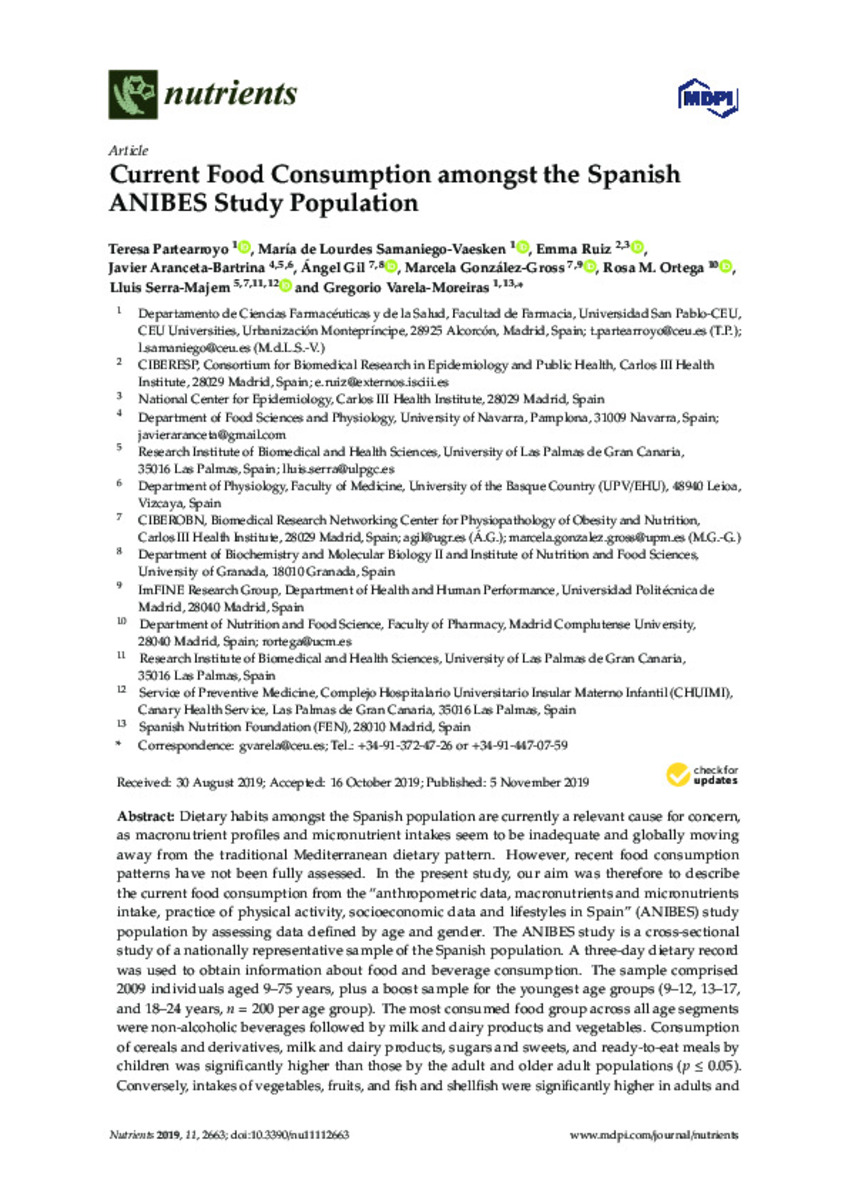Registro completo de metadatos
| Campo DC | Valor | Lengua/Idioma |
|---|---|---|
| dc.creator | Partearroyo, T. (Teresa) | - |
| dc.creator | Samaniego-Vaesken, M.L. (María de Lourdes) | - |
| dc.creator | Ruiz, E. (Emma) | - |
| dc.creator | Aranceta-Bartrina, J. (Javier) | - |
| dc.creator | Gil, A. (Ángel) | - |
| dc.creator | González-Gross, M. (Marcela) | - |
| dc.creator | Ortega, R.M. (Rosa María) | - |
| dc.creator | Serra-Majem, L. (Luis) | - |
| dc.creator | Varela-Moreiras, G. (Gregorio) | - |
| dc.date.accessioned | 2021-10-01T13:14:54Z | - |
| dc.date.available | 2021-10-01T13:14:54Z | - |
| dc.date.issued | 2019 | - |
| dc.identifier.citation | Partearroyo, T. (Teresa); Samaniego-Vaesken, M. L. (María de Lourdes); Ruiz, E. (Emma); et al. "Current Food Consumption amongst the Spanish ANIBES Study Population". Nutrients. 11 (2663), 2019, 1 - 15 | es |
| dc.identifier.issn | 2072-6643 | - |
| dc.identifier.other | PMID: 31694143 | - |
| dc.identifier.uri | https://hdl.handle.net/10171/62125 | - |
| dc.description.abstract | Dietary habits amongst the Spanish population are currently a relevant cause for concern, as macronutrient profiles and micronutrient intakes seem to be inadequate and globally moving away from the traditional Mediterranean dietary pattern. However, recent food consumption patterns have not been fully assessed. In the present study, our aim was therefore to describe the current food consumption from the "anthropometric data, macronutrients and micronutrients intake, practice of physical activity, socioeconomic data and lifestyles in Spain" (ANIBES) study population by assessing data defined by age and gender. The ANIBES study is a cross-sectional study of a nationally representative sample of the Spanish population. A three-day dietary record was used to obtain information about food and beverage consumption. The sample comprised 2009 individuals aged 9-75 years, plus a boost sample for the youngest age groups (9-12, 13-17, and 18-24 years, n = 200 per age group). The most consumed food group across all age segments were non-alcoholic beverages followed by milk and dairy products and vegetables. Consumption of cereals and derivatives, milk and dairy products, sugars and sweets, and ready-to-eat meals by children was significantly higher than those by the adult and older adult populations (p ≤ 0.05). Conversely, intakes of vegetables, fruits, and fish and shellfish were significantly higher in adults and older adults (p ≤ 0.05). In order to comply with recommendations, adherence to the Mediterranean dietary patterns should be strengthened, especially amongst younger population groups. Therefore, substantial nutritional interventions may be targeted to improve the Spanish population's dietary patterns nowadays. | es_ES |
| dc.description.sponsorship | The study was financially supported by a grant from Coca-Cola Iberia through an agreement with the Spanish Nutrition Foundation (Fundación Española de la Nutrición (FEN). The funding sponsor had no role in the design of the study, the collection, analysis nor interpretation of the data, the writing of the manuscript, or in the decision to publish the results. | es_ES |
| dc.language.iso | eng | es_ES |
| dc.publisher | MDPI AG | es_ES |
| dc.rights | info:eu-repo/semantics/openAccess | es_ES |
| dc.subject | Materias Investigacion::Ciencias de la Salud::Nutrición y dietética | es_ES |
| dc.subject | ANIBES study | es_ES |
| dc.subject | Spanish population | es_ES |
| dc.subject | Consumption | es_ES |
| dc.subject | Dietary pattern | es_ES |
| dc.subject | Food group | es_ES |
| dc.subject | Food subgroup | es_ES |
| dc.subject | Intake | es_ES |
| dc.title | Current Food Consumption amongst the Spanish ANIBES Study Population | es_ES |
| dc.type | info:eu-repo/semantics/article | es_ES |
| dc.description.note | This article is an open access article distributed under the terms and conditions of the Creative Commons Attribution (CC BY) license (http://creativecommons.org/licenses/by/4.0/). | es_ES |
| dc.identifier.doi | 10.3390/nu11112663 | - |
| dadun.citation.endingPage | 15 | es_ES |
| dadun.citation.number | 2663 | es_ES |
| dadun.citation.publicationName | Nutrients | es_ES |
| dadun.citation.startingPage | 1 | es_ES |
| dadun.citation.volume | 11 | es_ES |
Ficheros en este ítem:
Estadísticas e impacto
Los ítems de Dadun están protegidos por copyright, con todos los derechos reservados, a menos que se indique lo contrario.






